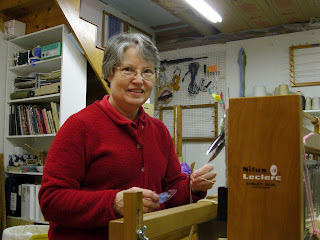There was a discussion recently on RugTalk (an online group for people interested in weaving rugs), about sewing rag strips together with a serger to prepare them for weaving. Although I have two sergers, I haven't used this method myself for rugs. My reasons for not using the serger are that I think I can do it just as quickly with my regular sewing machine, the serger uses more thread, and the seam isn't as stable as one made with a sewing machine.
The main positive reason I can think of for using the serger is that it saves some time trimming the little triangle away from the seam, since the serger does it while sewing the seam.
Don't think that because the serger has a cutter, it should be used to cut your fabric strips. It isn't a very fast method, and will quickly wear out the two blades on the serger, and eventually wear out the motor.
I would wait for a sale at the fabric store and purchase a rotary cutter, gridded cutting mat, and gridded 6" x 24" thick ruler like in the photo. The advantage to using the rotary cutter is that several layers of fabric can be cut at once, your width will be consistant, and it is FAST. Remember to keep the blade locked when you aren't cutting. If it accidently falls off your table, it is less likely to nick the blade or cut the dog or your foot!
Here are some tips to use a 3/4 thread serger. First of all, I would use the 4 thread (two needle) stitch to sew the strips together. The 3-thread stitch pulls apart too easily.
This is an example of a serged seam using 4 threads. The top of the seam is on the left and the underside is angling down. There are two straight stitches made by the needles, and the wavy back and forth threads are made by the upper and lower loopers. The straight stitches are only seen on the top side. If the tensions are properly balanced, those two straight rows of stitching only show on the top, and on the reverse side only as a tiny dot. The straight line down the center of the seam serves the purpose of making a more stable seam. It is harder to pull apart a 4-thread seam.

This is an example of a 3-thread seam. It looks the same on both sides of the seam. It doesn't have the added stabilizing thread, and a seam sewn with this can pull apart much easier. To be properly balanced, the tensions are adjusted till the threads interlock right at the edge. There are good uses for this stitch. It is a bit stretchier, so it is sometimes used in knit clothing seams. It will also stabilize an edge of fabric to prevent raveling.
This is an example of a three-thread seam that can pull apart quite easily.
Strips are cut and ready to start sewing together. For illustration purposes only, I have marked the stitching line on the fabric. The two strips are placed right sides together at a right angle. They will be sewn together with an angled seam to reduce bulk in one spot when weaving, so the rug won't look lumpy bumpy.
The toe on the serger presser foot has marks indicating where the two needles seams will be. The seam ripper is pointing at the mark where the outer needle will stitch. Line up the corner of the top fabric with that mark.
Stitch the seam. A little triangle of fabric will be trimmed off as the seam is sewn. When the end of the fabric gets to the front of the presser foot, flip the other end of the top fabric over so the right side is up, and add your next strip.
Continue sewing, without cutting the thread between, till quite a few are sewn together.
Clip the strips apart.
Fold strip in half. Seam is spread out in a "V", reducing bulk in one spot. A serger leaves chains of thread. If you gently pull on them, the looper threads will slide off the needle threads. Clip the tails.
Wind folded strips onto shuttle and weave a beautiful rug.
I still personally think that clipping all those tails, even if they are shorter than shown in the picture, take just as much time as sewing on a sewing machine, snipping the chain of strips apart, and trimming the small triangle off. Try it both ways and decide for yourself. Happy weaving!
 Here is one of my favorite weaving tools. The weaving craft can get kind of expensive, but this sleying hook is free.
Here is one of my favorite weaving tools. The weaving craft can get kind of expensive, but this sleying hook is free. companies. I tend to misplace things, so if I only had one sleying hook, I probably wouldn't get much weaving accomplished. By making my own, I can have one or a dozen by each loom. If I accidently drop one, I just pick up another one and keep going.
companies. I tend to misplace things, so if I only had one sleying hook, I probably wouldn't get much weaving accomplished. By making my own, I can have one or a dozen by each loom. If I accidently drop one, I just pick up another one and keep going.











